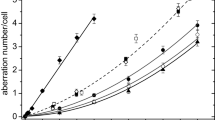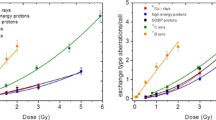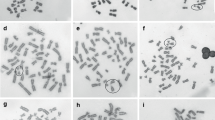Summary
-
1.
X-ray fractionation experiments have been made with varying intervals which separate two dose fractions.
-
2.
Effects of a range of intensities on the yield of chromosome aberrations due to the two dose fractions separated by different time intervals have been studied.
-
3.
The experiments provide evidence for delayed action in the breakage of chromosomes by X-rays.
-
4.
The average life of a break to remain open has been found to be short (a few minutes), but it is probable that a break can occasionally remain open for many hours.
-
5.
The effects of varying intensities upon the breakage process have been discussed. I am greatly indebted to Professor J. S. Mitchell for his continued interest and help, to Professor D. G-. Catcheside for his helpful introduction to the scoring methods and to Dr P. C. Koller for valuable criticisms. To Miss R. D. Saunders and Mr L. Gurner my thanks for their technical assistance.
A financial grant from the Government of India and Assam made this work possible.
Similar content being viewed by others
References
Auerbach, C. &Robson, J. M. (1944). Production of mutations by allyl isothiocyanate.Nature, Lond.,154, 81.
Barron, E. S. G., Dickman, S., Muntz, J. A. &Singer, T. P. (1949). Actions of ionizing radiations, (1) inhibition of enzymes by X-rays.J. Gen. Physiol. 32, 595–605.
Bishop, C. J. (1950). Differential X-ray sensitivity ofTradescantia chromosomes during the mitotic cycle.Genetics,35, 175–87.
Bishop, C. J. (1952). The influence of polyploidy on the X-ray sensitivity of cells.Ganad. J. Bot. 30, 139–46.
Conger, A. D. &Eatrchild, L. M. (1952). Breakage of chromosomes by oxygen.Proc. Nat. Acad. Sci., Wash.,38, 4, 289–99.
Crabtree, H. G. &Crameb, W. (1933). The action of radium on cancer cells. II. Some factors determining susceptibility of cancer cells to radium.Proc. Roy. Soc. B,113, 238–50.
Dale, W. M. (1942). The effects of X-rays on the conjugated D-amino-acid oxidase.Biochem. J. 36, 80–5.
Darlington, O. D. &Koller, P. C. (1947). The chemical breakage of chromosomes.Heredity,1, 187–221.
Darlington, C. D. &La Gour, L. F. (1945). Chromosome breakage and nucleic acid cycle.J. Genet. 46, 180–267.
Euler, H. &Hevesy, G. (1942).K. danske vidensk. Selsk., Biol. Medd.,17, 8.
Fano, U. &Marinelli, L. D. (1943). Note on the time-intensity factor in radiobiology.Proc. Nat. Acad. Sci., Wash.,29, 59–66.
Fricke, H. &Demerec, M. (1937). The influence of wavelength on genetic effects of X-rays.Proc. Nat. Acad. Sci., Wash.,23, 320–7.
Hevesy, G. (1945). The short lived inhibition of nucleic acid formation caused by X-ray irradiation.Ark. Kemi. Min. Geol. B,18, 15, 5.
Hevesy, G. (1946). Effect of X-rays on rate of turnover of phosphatides.Nature, Land.,158, 268.
Hevesy, G. (1949). Effects of X-rays on the incorporation of carbon-14 into desoxyribonucleic acid.Nature, Lond.,163, 869–70.
Holmes, B. E. (1947). The inhibition of ribo- and thymo-nucleic acid synthesis in the tumor tissue by irradiation with X-rays.J. Brit. Radiol. 20, 239, 450–3.
Jordan, P. (1938). Methods and results of radiobiological research.Radiologica, Berl.,3, 157.
Kotval, J. P. &Gray, L. H. (1947). Structural changes produced in microspores ofTradescantia by α-radiations.J. Genet. 48, 135–54.
Lane, R. G. (1951). X-ray fractionation and chromosome breakage.Heredity,5, 1–35.
Lea, D. E. (1946).Actions of Radiations on Living Cells. Cambridge.
Lea, D. E. &Catcheside, D. G. (1942). The mechanism of the induction by radiation of chromosome aberrations inTradescantia.J. Genet. 44, 216–45.
Mitchell, J. S. (1940). Increase in ultra-violet absorption of cytoplasm after X- and gamma-irradiation.Nature, Lond.,146, 272–3.
Mitchell, J. S. (1942a). Disturbance of nucleic acid metabolism produced by therapeutic doses of X-and gamma-radiations. Part I. Methods of investigation.Brit. J. Exp. Path. 23, 285.
Mitchell, J. S. (1942b). Disturbance of nucleic acid metabolism produced by therapeutic doses of X-and gamma-radiations. Part II. Accumulation of pentose nucleotides in cytoplasm after irradiation.Brit. J. Exp. Path. 23, 296.
Mitchell, J. S. (1942c). Disturbance of nucleic acid metabolism produced by therapeutic doses of X-and gamma-radiations. Part III. Inhibition of synthesis of thymonucleic acid by radiation.Brit. J. Exp. Path. 23, 310.
Mitchell, J. S. (1943). Metabolic effects of therapeutic doses of X- and gamma-radiations.J. Brit. Radiol. 16, 339–43.
Mottram, J. C. (1935). On the alteration in the sensitivity of cells towards radiation produced by cold and anaerobiosis.Brit. J. Radiol. 8, 1, 32–9.
Muller, H. J. (1940). An analysis of the process of structural changes in chromosomes ofDrosophila.J. Genet. 40, 1–66.
Sax, K. (1938). Chromosome aberrations induced by X-rays.Genetics,23, 494–516.
Timoféeff-Ressovsky, N. W. (1937).Mutationsforschung. Dresden: Steinkopff.
Thoday, J. M. (1942). The effect of ionizing radiations on chromosomes ofTradescantia bracteata. Comparison between neutrons and X-rays.J. Genet. 43, 189–210.
Thoday, J. M. &Read, J. (1947). Effect of oxygen on the frequency of chromosome aberrations produced by X-rays.Nature, Lond.,160, 608.
Author information
Authors and Affiliations
Rights and permissions
About this article
Cite this article
Bora, K.C. Delayed effects in chromosome breakage by x-rays intradescantia bracteata . Journ. of Genetics 52, 140–151 (1954). https://doi.org/10.1007/BF02981495
Issue Date:
DOI: https://doi.org/10.1007/BF02981495




